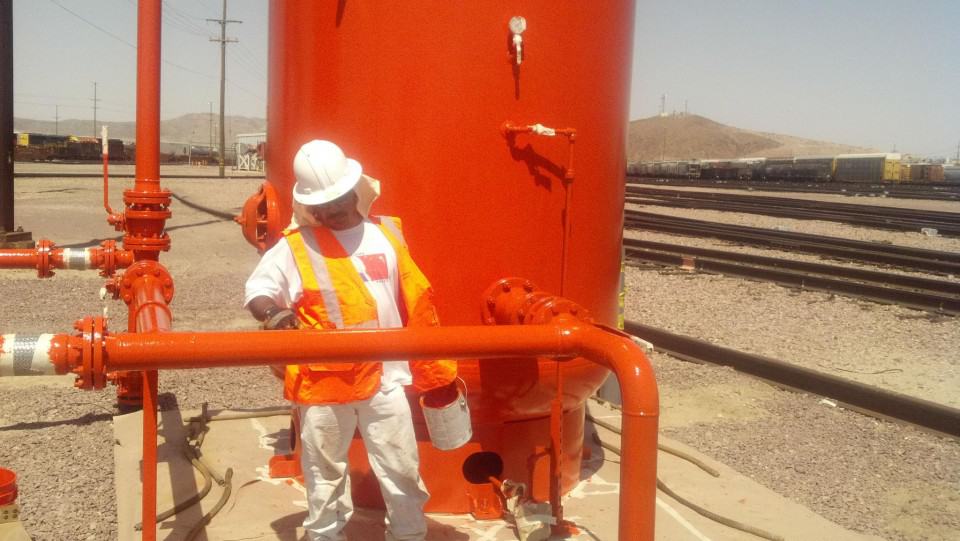One of the most important innovations in industrial technology has been the introduction of epoxy coatings for protection and increased longevity of equipment. Not only can these make work environments safer, they can also drastically expand the life of a product, especially when it comes into contact regularly with corrosive or eroding substances.
What Are Epoxy Coatings?
At their base, epoxy is the result of curing epoxy resins. It is primarily used as an adhesive to stick things together and forms incredibly strong chemical bonds, making it very effective at this. They share some chemical commonalities with certain types of synthetic plastics, which is why they often have a consistency similar to those in the dried state.
Epoxy resins are also known as polyexpoxides, and are either prepolymers or polymers with an epoxide group attached. While they are often reacted (or “cross-linked”) with themselves – the reason why most epoxy coatings require you to mix two or more components together – they can actually be reacted with a number of different substances, including phenols and various acids. Part of what makes epoxy such a useful industrial material is that there is a wide range of co-reactants that can be used to cure and activate it. These can affect the curing process, and provide a wide range of possible applications for epoxy coatings.
Epoxy resins are generally petroleum-derived in a modern context, though some that are plant-derived due to improved technology are slowly working their way onto the market. They are polymeric or semi-polymeric in nature, meaning that they very rarely exist as “pure” materials with a consistent molecular chain length. In fact, it’s the variable chain length of the molecules that causes the resin to react as well as it does, making the impurities part of the secret to why it works.
The Curing Process
There are a number of ways to cure an epoxy resin. This curing process is necessary because uncured resins generally have poor mechanical, chemical, and heat resistance. Simply putting the resin on something is not the same as using a genuine epoxy which has undergone the reactions necessary to have the greatest effect.
The curing process is an exothermic reaction, meaning that it produces heat, sometimes enough to degrade nearby materials if it isn’t carefully controlled. As mentioned above, there are a number of different reactants that can be combine with resin to create an epoxy, and each produces a different kind of curing.
Reacting an epoxy with itself, called homopolymerization, creates a molecular network that exhibits high resistance to heat and chemicals, but is physically brittle and needs high temperatures to cure properly. Amine reactions can be accomplished in one or two steps and produce an epoxy with high temperature resistance that is less brittle than homopolymerized epoxy, but doesn’t have the same chemical resistance. Anhydride curing creates an epoxy with a low viscosity and a high latency, making them good for applications like high voltage electrical insulation. Phenol hardeners react at high temperatures with a catalyst, and are usually powder coatings because key components of them are solid. Finally, Thiol reactants don’t provide a high temperature or chemical resistance, but they can be cured at reasonably low temperatures and quickly if it’s necessary.
Using Epoxy Coatings
There are a number of incredible uses for epoxy coatings in an industrial setting. From epoxy floor coatings to chemical resistant equipment epoxies, there is very little that the right kind can’t protect.
Most common among the various applications of epoxy are epoxy floor coatings. Part of the reason why epoxy floor coating is so popular is that it can accomplish a number of tasks with a reasonably simple application, and shows rapid turnaround on the investment.
In an industrial setting, epoxy flooring can be excellent for decks that are outdoors or otherwise exposed to the elements. Putting floor coatings on a loading dock, for example, can not only protect the deck from erosion due to wind, rain, and snow, but can also provide an extra layer of defense against dropped boxes, sliding cargo, and scraping bumpers.
Floor coatings can also be used to add traction to an otherwise slippery area. Bare concrete can be very slick, especially if wet, and the resulting injuries can not only cost the company in worker’s compensation, but also impact the workforce itself. An epoxy floor coating can significantly reduce these incidents.
Other than epoxy flooring, though, there are a number of coating uses available, including to line tanks and pipes that hold and transport particularly corrosive chemicals. Providing an extra layer of protection from parts that have liquid consistently eroding them is another way that epoxy can benefit a company. Such coatings can also be used to fill in cracks and other damage that occurred before their installation. There are nearly limitless applications for epoxy in an industrial setting.
Professional Installation
While many companies consider installing their epoxy solutions themselves, it is often a good idea to have a professional company handle it. While a properly applied coating can increase the life of a piece of equipment by decades in some cases, improperly applied coatings can provide a false sense of security and even endanger people.
Part of what goes into epoxy installation is preparing the surface to take the epoxy. In some cases this is a highly specialized cleaning process. In others, it may require a certain amount of grading or physically altering the surface so that the epoxy will stay in place. The thickness of the epoxy also plays a role in proper application, and that can change based on a number of factors. It is more involved than your average industrial painting job, in other words.
That all being said, a properly installed floor or protective layer is an excellent investment, and one of the easiest available. There is very little reason not to get high quality epoxy coatings at your plant.



